Don't wanna be here? Send us removal request.
Link
Veer O Metals was established in 1965. We are engaged in the manufacture of Stamped Parts, Precision Sheet Metal Fabrication Parts, Machined Components and Mechanical Assemblies. We have an in-house strong Mechanical Engineering and Manufacturing team for Design and Development, dedicated in providing high end design solutions which are industry specific.
We have established a strong client base at National and International level with our transparent and Global practices, and at the same time retaining robust quality management systems. By developing indigenously designed products of global standards for various sectors, we have added a new dimension to our already existing wide range of product manufacturing and assemblies.
With a core principle of innovation and enhanced technology, Veero always has been at the forefront in embracing the newest trends in the industry. Introducing first of its kind Metal Additive Manufacturing (Metal 3D Printing). Veero has augmented cutting edge manufacturing technology in the field of metal additive manufacturing. It is a Disruptive Technology, which is an automatic process of manufacturing objects (Parts, Prototypes, tools & even assemblies) directly from their CAD models without any cutter, tools and jigs & fixtures.
From inventions to innovations, energy responsibility to environment stewardship, Veer O Metals is well positioned to be a technology leader in manufacturing of sheet metal fabrication parts and mechanical assemblies.
We are proud to mention that we are the most preferred partner for our clients. We have state of the art manufacturing locations in India and Philippines.
Our core activities have been in:
Stamping Components
Precision Sheet Metal Fabrication Parts
Enclosures
Industrial and IT Racks
Mechanical Assemblies
Machined Components
Veer O Products
Metal Additive Manufacturing ( 3D Printing )
Our approach to manufacturing excellence entails stringent quality checks and continual improvements.
#post processing of 3d printed#additive manufacturing company#additive manufacturing application#metal 3d printing companies in bangalore#materials used in additive manufacturing#dmls machine cost in india#3d priniting post processing services#dmls printer manufacturers#metal manufacturers in india#metal 3d printing in chennai#3d metal printing machine manufacturers#metal 3d printing process#3d printing in defence industry#metal companies in india#metal 3d printing in mumbai#metal 3d printing services in india#3d metal printing near me#metal 3d printing materials#additive manufactured products#metal 3d printing manufacturing#metal 3d printing companies in india#metal 3d printing service bangalore#additive manufacturing company in india#additive manufacturing companies in bangalore#additive manufacturing service in india#metal 3d printing bangalore#metal additive manufacturing systems#additive manufacturing metal parts#additive metal 3d printing#metal additive manufacturing machine
0 notes
Text
top 3d printing companies - metals manufacturing company
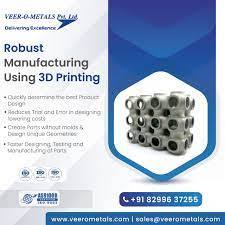
Will you disagree with me if I say that the long-term success of any society is highly dependent on its manufacturing? I hope you will not. Every society needs a very strong and vibrant manufacturing base. There is a well-known saying that 'If you always do what you always did, you'll always get what you have always got. This clearly states the significance of development and automation in the manufacturing industry. Additive manufacturing is fundamentally changing what we can do. There are three key elements to effectively utilize the additive manufacturing process. Additive thinking, accessible processes and cost are those elements which provide the most efficient solutions to the hindrances in the additive manufacturing sector. Metal additive manufacturing is the one that requires special mention here. Let us understand the concept, types, and major metal additive manufacturing applications.
What is Metal 3D Printing
Metal 3d printing, also known as metal additive manufacturing is one of g fastest growing technologies in the manufacturing industry. It is the most heavily invested technology in industrial and business applications. Any technology that creates metal objects layer by layer with sintering, melting and welding could be called metal 3D printing. Metal additive manufacturing stands as an umbrella term for several families of AM technologies. The application of metal 3d printing is boundless when manufacturing objects with complicated geometry. 3D printing is highly recommended for intricate parts where other types of manufacturing are inefficient or difficult to use.
Types of Metal 3D Printing
For a better understanding of the types of metal additive manufacturing, one should differentiate between powder-bed welding and deposition processes such as laser deposition welding. In powder bed welding, a slider is used to apply a thin layer of metallic material onto the building platform. Then a laser or electron beam cuts out the desired shape. Then the installation space is lowered a little and the next layer of metal powder is pushed over the object. In this way, the component is created layer by layer. The methods of metal 3d printing are categorised into four namely Selective Laser Melting (SLM), Electron Beam Melting (EBM), Laser Metal Deposition (LMD) and Metal Powder Application (MPA). SLM technology uses a bed of powder with a source of heat to create metal parts and includes Selective Laser Melting (SLS), which is also called Direct Metal Laser Sintering (DMLS) or Laser Metal Fusion (LMF). EBM is a type of additive manufacturing where the raw material is placed under a vacuum and fused from heating by an electron beam. LMD is a laser-based DED technique that selectively adds metal material onto a base workpiece in a layer-by-layer process. In powder-based LMD, a nozzle aggregates metal powder onto a workpiece, where a fibre laser melts both the powder and the workpiece into a melt pool. MPA involves blasting a fine metal powder at a target using a custom-designed nozzle.
3D Printing in Automobile Industry
3D printing has greater scope in the automobile industry. Metal additive manufacturing can be used to make moulds and thermoforming tools, and also in manufacturing grips, jigs, and fixtures. This allows automakers to produce samples and tools at low costs and to eliminate future losses in production when investing in high-cost tooling. With 3D printing, automotive designers can quickly fabricate a prototype of a physical part or assembly, from a simple interior element to a dashboard or even a scale model of an entire automobile.
3D Printing in Medical Industry
Medical 3D printing is highly in demand in both clinical and research-based healthcare activities. It involves the creation of physical replicas of anatomical structures using additive manufacturing processes. The application of 3D printing in medicine can provide many benefits like the customization and personalization of medical products, drugs, and equipment; cost-effectiveness; increased productivity; the democratization of design and manufacturing; and enhanced collaboration.
3D Printing in Aerospace Industry
In the Aerospace industry, metal additive manufacturing is used to manufacture metal brackets that perform a structural function inside aircraft. 3D printing services produce interior aircraft components such as cockpit dashboards and door handles. 3D printed prototypes enable designers to refine the form and fit of finished parts. Because component precision is a critical factor in aircraft design, 3D printers are used in the aircraft industry to provide extremely high accuracy in parts and components.
3D Printing in Architecture Industry
3D printing will simplify the process in architecture. It can render highly detailed physical models from a range of materials and colours based on a CAD model. It is an efficient process that lets architects turn out models quickly and more accurately. 3D printing allows architects to design and develop everything ranging from buildings, townships, and cities right down to terrains, landscapes and fauna with fine detail and full colour. Well-designed 3D-printed architectural models can help architects create a lasting impression on their clients.
3D Printing in Defense Industry
The additive manufacturing technique is widely used by the defence sector worldwide. Considering that speed, lighter weights, and lower costs are all paramount in this sector, additive manufacturing certainly has a role to play. 3d printing provides new ways to 3D print replacement parts on demand, whilst reducing production costs and enabling new design engineering possibilities in the defence industry.
3D Printing in Tooling Industry
Tooling is any part manufacturers use to make other parts. 3D printing provides new opportunities for different business sectors to enable easier prototyping. It could directly form the part or like a pattern for a mould that manufacturers would then use to cast a different part. It gives them the ability to create designs that are way too difficult to produce with other methods. It also allows manufacturers to build high-quality products rapidly.
Some new frontiers with 3D printing technology
A new frontier for 3D printing develops state-of-the-art soft materials able to self-heal. The scientific community is focusing its research on the multiple applications of hydrogels, polymeric materials which contain a large amount of water, that have the potential to reproduce the features of biological tissues. Direct Sound Printing is a potential game-changer in 3D Printing. Metal additive manufacturing creates physical objects from a geometrical representation by successive addition of materials. 3D printing technology is a fast-emerging technology nowadays. Apart from Metal 3D Printing, there are new frontiers like 3D Printed Lattice Structures, Bone-Like 3D Printed Structures and more efficient Engines in Drones. 3D printing can help manufacturers save time, material, and costs from traditional tooling processes. As technology in 3D printing has improved, the ability to make larger items as well as more detailed objects has become more commonplace. Ultimately, three-dimensional printing is revolutionizing the production of new devices and structures in a wide range of sectors.
Conclusion
Metal additive manufacturing has recently developed a lot to bring great benefits to different business sectors. These benefits include reduced material use, lowered costs, and production acceleration. It also enables designers and engineers to create anything from jigs and fixtures to more advanced forms like visualisation aids. The possibilities of using 3D printing for product development and manufacturing in different industries are limitless. The days are not far for you to think of outsourcing metal 3d printing for your industry. The countdown begins!
#3d metal printing companies#3d metal printing machine#3d metal printing prototyping#additive laser manufacturing#additive manufacturing 3d printing#additive manufacturing advantages#additive manufacturing aerospace#additive manufacturing future#additive manufacturing near me#additive manufacturing process#additive manufacturing technique#additive manufacturing types#advantages of 3d printers#automotive industry 3d printing#benefit of metal 3d printing#best 3d printing companies in bangalore#dmls 3d printer#dmls 3d printing process#dmls 3d printing service#dmls additive manufacturing#dmls machine manufacturers#dmls post processing#dmls process#dmls rapid prototyping#industrial 3d printer price in india#metal 3d printer price in india#metal 3d printing in automotive industry#metal 3d printing in rapid prototyping#metal 3d printing prototype#metal 3d printing service
0 notes
Photo
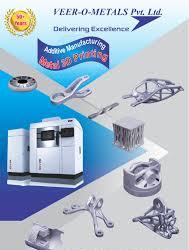
top 3d printing companies
#3d metal printing companies#3d metal printing machine#3d metal printing prototyping#additive laser manufacturing#additive manufacturing 3d printing#additive manufacturing advantages#additive manufacturing aerospace#additive manufacturing future#additive manufacturing near me#additive manufacturing process#additive manufacturing technique#additive manufacturing types#advantages of 3d printers#automotive industry 3d printing#benefit of metal 3d printing#best 3d printing companies in bangalore#dmls 3d printer#dmls 3d printing process#dmls 3d printing service#dmls additive manufacturing#dmls machine manufacturers#dmls post processing#dmls process#dmls rapid prototyping#industrial 3d printer price in india#metal 3d printer price in india#metal 3d printing in automotive industry#metal 3d printing in rapid prototyping#metal 3d printing prototype#metal 3d printing service
0 notes
Text
6 MOST POPULAR INDUSTRIES TO USE METAL 3D PRINTING
The beauty of art lies not only in what all elements we add to it but also in, what elements we take out from it. This is what vests under the concept of Metal Additive Manufacturing, in common terms, referred to as Metal 3D Printing. It is an output of the biggest leap in technology that produces three-dimensional parts layer by layer from a metal material. In the modern era of technological innovations, there is no point in asking if it is possible to 3D print items from metal. The technology of Metal Additive Manufacturing makes it possible in the best way. Let us know how metal additive manufacturing works, the different types of metal 3D printing, its likely advantages and possible applications.
What is Metal 3D Printing?
A laser-based technology in manufacturing that uses powdered metals can be termed metal 3D printing. A vast variety of materials are available in powdered form for metal 3D printing in India including titanium, steel, stainless steel, aluminium, copper, cobalt chrome, tungsten and nickel-based alloys. They are known as 3D printing metal powders. Precious metals like gold, platinum and silver are also attainable. They are now recognised as 3D printing precious metals. So metal powder is the backbone of metal 3D printing. It is difficult and dangerous to handle in its raw state yet very widely used because of its unique features.
Types of Metal 3D Printing
As metal 3D printing technology uses powdered metals, the differences in metal 3D printing types are based on how they fuse the powder into metal parts. These methods vary considerably. It ranges from using high-energy lasers to fuse the loose powder to extruding bound metal powder filament. The most common type and widely used method is the powder bed fusion technique. In this method, machines distribute a fine layer of powder over a build plate and selectively melt a cross-section of the part into the powder layer. It is of two types: Selective Laser Melting and Electron Beam Melting. SLM machines use high-powered lasers to fuse metal layers into parts. EBM machines use an electron beam instead of a laser to fabricate parts. Then there is another method called Direct energy deposition that uses metal feedstock and a laser to fabricate parts. Another method is the EBAM technique where the Wire DED machines use a laser to melt feedstock, which is a metal wire instead of blown powder. There is the Binder Jetting method which is a large-scale, high-fidelity method of metal 3D printing. Bound Powder Extrusion (BPE) is the newest method of metal additive manufacturing. Here, the powder is bound together in waxy polymers which makes it much safer and easier to use than loose powder. Then there is the latest concept of FDM 3D metal printing which is Fused Deposition Modelling which is a plastic extrusion process. In addition to plastics, some FFF/FDM 3D printers are capable of printing metal filaments.
Advantages of Metal 3D Printing
The main advantage of Metal 3D printing is that it saves time and cost, which is very important to the manufacturing sector. Metal 3D printing uses simulation to improve the quality of the part manufactured and thus minimizes the risk of production failure. In discrete manufacturing processes, this is very much important. Another advantage of Metal 3D printing lies in its adaptability for customization. The technology can produce structures as per customer needs. The process is highly recommended to design complex components cost-effectively, create functional designs without manufacturing limitations, cut the investment in manufacturing tools, shorten the time to market and eliminate stock-related costs and risks.
Metal 3D printing Applications
Every technology has its potential applications. Metal 3D printing is no different. The typical 3D metal printing applications include fully functional prototyping, creating production tools, tooling for moulds or inserts, housings, ductwork, heat exchangers and heatsinks. It is well suited to manufacturing relatively small yet complex parts, including prototypes. It can also facilitate tooling for conventional manufacturing technologies in a much more cost-effective manner. Besides, It has wide applications in various sectors like Aerospace & Mechanical Engineering. The flexibility of 3D printing combined with the mechanical properties of metal makes this technology a boom and has found its space across the industry.
Let's Sum Up
As the world extends its dimensions, we need to extend ours too. As 3D metal printing is now available to home users also, it is now easy to print a wide variety of 3D objects. Because this metal additive manufacturing is time-consuming, complicated and expensive, it is difficult for it to be a common process. But as the technology develops, the constraints shrink and there will be a time when Metal 3D printing is widely used to change the dimensions of the world. Let us hope for such a moment where we can affordably do a lot of innovative 3D printing as commonly as now we do the printing on paper. Now regarding the cost of metal 3D printing, it can be incredibly cost-effective for the first 200 to 20,000 parts. Direct metal laser melting is a productive method for low-cost 3D metal printing. Apart from cost, metal 3d printing in India depends on factors such as the volume of your 3D model, complexity and the type of finishing that you use. Nowadays, there is a newer aspect of liquid metal 3D printing. It uses a laser to cure liquid photopolymer resin into solid isotropic parts. They produce an output having sharp edges, a smooth surface finish,dmls 3d printing service
and minimal visible layer lines.
#3d metal printing companies#3d metal printing machine#3d metal printing machine manufacturers#3d metal printing near me#3d metal printing prototyping#3d priniting post processing services#3d printing in defence industry#additive laser manufacturing#additive manufactured products#additive manufacturing 3d printing#additive manufacturing advantages#additive manufacturing aerospace#additive manufacturing application#additive manufacturing companies in bangalore#additive manufacturing company#additive manufacturing company in india#additive manufacturing future#additive manufacturing material#additive manufacturing metal parts#additive manufacturing near me#additive manufacturing process#additive manufacturing service in india#additive manufacturing technique#additive manufacturing types#additive metal 3d printing#advantages of 3d printers#automotive industry 3d printing#benefit of metal 3d printing#best 3d printing companies in bangalore#dmls 3d printer
0 notes
Conversation
6 MOST POPULAR INDUSTRIES TO USE METAL 3D PRINTING
Metal additive manufacturing has recently developed a lot to bring great benefits to different business sectors. These benefits include reduced material use, lowered costs, and production acceleration. It also enables designers and engineers to create anything from jigs and fixtures to more advanced forms like visualisation aids. The possibilities of using 3D printing for product development and manufacturing in different industries are limitless. The days are not far for you to think of outsourcing metal 3d printing for your industry. The countdown begins!
#3d metal printing machine manufacturers#3d priniting post processing services#3d printing in defence industry#additive manufactured products#additive manufacturing companies in bangalore#additive manufacturing company#additive manufacturing company in india#additive manufacturing material#additive manufacturing metal parts#additive manufacturing service in india#additive metal 3d printing#dmls machine cost in india#dmls printer manufacturers#materials for additive manufacturing#materials used in additive manufacturing#metal 3d printing bangalore#metal 3d printing companies in bangalore#metal 3d printing companies in india#metal 3d printing in chennai#metal 3d printing in mumbai#metal 3d printing india#metal 3d printing manufacturing#metal 3d printing post processing#metal 3d printing process#metal 3d printing raw material#metal 3d printing services in india#metal additive manufacturing#metal additive manufacturing applications#metal additive manufacturing companies#metal additive manufacturing in india
0 notes
Quote
6 MOST POPULAR INDUSTRIES TO USE METAL 3D PRINTING
Metal additive manufacturing has recently developed a lot to bring great benefits to different business sectors. These benefits include reduced material use, lowered costs, and production acceleration. It also enables designers and engineers to create anything from jigs and fixtures to more advanced forms like visualisation aids. The possibilities of using 3D printing for product development and manufacturing in different industries are limitless. The days are not far for you to think of outsourcing metal 3d printing for your industry. The countdown begins!
#3d metal printing machine manufacturers#3d priniting post processing services#3d printing in defence industry#additive manufactured products#additive manufacturing companies in bangalore#additive manufacturing company#additive manufacturing company in india#additive manufacturing material#additive manufacturing metal parts#additive manufacturing service in india#additive metal 3d printing#dmls machine cost in india#dmls printer manufacturers#materials for additive manufacturing#materials used in additive manufacturing#metal 3d printing bangalore#metal 3d printing companies in bangalore#metal 3d printing companies in india#metal 3d printing in chennai#metal 3d printing in mumbai#metal 3d printing india#metal 3d printing manufacturing#metal 3d printing post processing#metal 3d printing process#metal 3d printing raw material#metal 3d printing services in india#metal additive manufacturing#metal additive manufacturing applications#metal additive manufacturing companies#metal additive manufacturing in india
0 notes
Photo
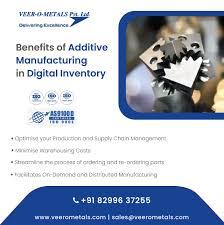
#3d metal printing machine manufacturers#3d priniting post processing services#3d printing in defence industry#additive manufactured products#additive manufacturing companies in bangalore#additive manufacturing company#additive manufacturing company in india#additive manufacturing material#additive manufacturing metal parts#additive manufacturing service in india#additive metal 3d printing#dmls machine cost in india#dmls printer manufacturers#materials for additive manufacturing#materials used in additive manufacturing#metal 3d printing bangalore#metal 3d printing companies in bangalore#metal 3d printing companies in india#metal 3d printing in chennai#metal 3d printing in mumbai.#metal 3d printing india#metal 3d printing manufacturing#metal 3d printing post processing#metal 3d printing process#metal 3d printing raw material#metal 3d printing services in india#metal additive manufacturing#metal additive manufacturing applications#metal additive manufacturing companies.#metal additive manufacturing in india
0 notes
Text
6 MOST POPULAR INDUSTRIES TO USE METAL 3D PRINTING
Will you disagree with me if I say that the long-term success of any society is highly dependent on its manufacturing? I hope you will not. Every society needs a very strong and vibrant manufacturing base. There is a well-known saying that 'If you always do what you always did, you'll always get what you have always got. This clearly states the significance of development and automation in the manufacturing industry. Additive manufacturing is fundamentally changing what we can do. There are three key elements to effectively utilize the additive manufacturing process. Additive thinking, accessible processes and cost are those elements which provide the most efficient solutions to the hindrances in the additive manufacturing sector. Metal additive manufacturing is the one that requires special mention here. Let us understand the concept, types, and major metal additive manufacturing applications.
What is Metal 3D Printing
Metal 3d printing, also known as metal additive manufacturing is one of g fastest growing technologies in the manufacturing industry. It is the most heavily invested technology in industrial and business applications. Any technology that creates metal objects layer by layer with sintering, melting and welding could be called metal 3D printing. Metal additive manufacturing stands as an umbrella term for several families of AM technologies. The application of metal 3d printing is boundless when manufacturing objects with complicated geometry. 3D printing is highly recommended for intricate parts where other types of manufacturing are inefficient or difficult to use.
Types of Metal 3D Printing
For a better understanding of the types of metal additive manufacturing, one should differentiate between powder-bed welding and deposition processes such as laser deposition welding. In powder bed welding, a slider is used to apply a thin layer of metallic material onto the building platform. Then a laser or electron beam cuts out the desired shape. Then the installation space is lowered a little and the next layer of metal powder is pushed over the object. In this way, the component is created layer by layer. The methods of metal 3d printing are categorised into four namely Selective Laser Melting (SLM), Electron Beam Melting (EBM), Laser Metal Deposition (LMD) and Metal Powder Application (MPA). SLM technology uses a bed of powder with a source of heat to create metal parts and includes Selective Laser Melting (SLS), which is also called Direct Metal Laser Sintering (DMLS) or Laser Metal Fusion (LMF). EBM is a type of additive manufacturing where the raw material is placed under a vacuum and fused from heating by an electron beam. LMD is a laser-based DED technique that selectively adds metal material onto a base workpiece in a layer-by-layer process. In powder-based LMD, a nozzle aggregates metal powder onto a workpiece, where a fibre laser melts both the powder and the workpiece into a melt pool. MPA involves blasting a fine metal powder at a target using a custom-designed nozzle.
3D Printing in Automobile Industry
3D printing has greater scope in the automobile industry. Metal additive manufacturing can be used to make moulds and thermoforming tools, and also in manufacturing grips, jigs, and fixtures. This allows automakers to produce samples and tools at low costs and to eliminate future losses in production when investing in high-cost tooling. With 3D printing, automotive designers can quickly fabricate a prototype of a physical part or assembly, from a simple interior element to a dashboard or even a scale model of an entire automobile.
3D Printing in Medical Industry
Medical 3D printing is highly in demand in both clinical and research-based healthcare activities. It involves the creation of physical replicas of anatomical structures using additive manufacturing processes. The application of 3D printing in medicine can provide many benefits like the customization and personalization of medical products, drugs, and equipment; cost-effectiveness; increased productivity; the democratization of design and manufacturing; and enhanced collaboration.
3D Printing in Aerospace Industry
In the Aerospace industry, metal additive manufacturing is used to manufacture metal brackets that perform a structural function inside aircraft. 3D printing services produce interior aircraft components such as cockpit dashboards and door handles. 3D printed prototypes enable designers to refine the form and fit of finished parts. Because component precision is a critical factor in aircraft design, 3D printers are used in the aircraft industry to provide extremely high accuracy in parts and components.
3D Printing in Architecture Industry
3D printing will simplify the process in architecture. It can render highly detailed physical models from a range of materials and colours based on a CAD model. It is an efficient process that lets architects turn out models quickly and more accurately. 3D printing allows architects to design and develop everything ranging from buildings, townships, and cities right down to terrains, landscapes and fauna with fine detail and full colour. Well-designed 3D-printed architectural models can help architects create a lasting impression on their clients.
3D Printing in Defense Industry
The additive manufacturing technique is widely used by the defence sector worldwide. Considering that speed, lighter weights, and lower costs are all paramount in this sector, additive manufacturing certainly has a role to play. 3d printing provides new ways to 3D print replacement parts on demand, whilst reducing production costs and enabling new design engineering possibilities in the defence industry.
3D Printing in Tooling Industry
Tooling is any part manufacturers use to make other parts. 3D printing provides new opportunities for different business sectors to enable easier prototyping. It could directly form the part or like a pattern for a mould that manufacturers would then use to cast a different part. It gives them the ability to create designs that are way too difficult to produce with other methods. It also allows manufacturers to build high-quality products rapidly.
Some new frontiers with 3D printing technology
A new frontier for 3D printing develops state-of-the-art soft materials able to self-heal. The scientific community is focusing its research on the multiple applications of hydrogels, polymeric materials which contain a large amount of water, that have the potential to reproduce the features of biological tissues. Direct Sound Printing is a potential game-changer in 3D Printing. Metal additive manufacturing creates physical objects from a geometrical representation by successive addition of materials. 3D printing technology is a fast-emerging technology nowadays. Apart from Metal 3D Printing, there are new frontiers like 3D Printed Lattice Structures, Bone-Like 3D Printed Structures and more efficient Engines in Drones. 3D printing can help manufacturers save time, material, and costs from traditional tooling processes. As technology in 3D printing has improved, the ability to make larger items as well as more detailed objects has become more commonplace. Ultimately, three-dimensional printing is revolutionizing the production of new devices and structures in a wide range of sectors.
Conclusion
Metal additive manufacturing has recently developed a lot to bring great benefits to different business sectors. These benefits include reduced material use, lowered costs, and production acceleration. It also enables designers and engineers to create anything from jigs and fixtures to more advanced forms like visualisation aids. The possibilities of using 3D printing for product development and manufacturing in different industries are limitless. The days are not far for you to think of outsourcing metal 3d printing for your industry. The countdown begins!
#3d metal printing companies#3d metal printing machine#3d metal printing machine manufacturers#3d metal printing near me#3d metal printing prototyping#3d priniting post processing services#3d printing in defence industry#additive laser manufacturing#additive manufactured products#additive manufacturing 3d printing#additive manufacturing advantages#additive manufacturing aerospace#additive manufacturing application#additive manufacturing companies in bangalore#additive manufacturing company#additive manufacturing company in india#additive manufacturing future#additive manufacturing material#additive manufacturing metal parts#additive manufacturing near me#additive manufacturing process#additive manufacturing service in india#additive manufacturing technique#additive manufacturing types#additive metal 3d printing#advantages of 3d printers#automotive industry 3d printing#benefit of metal 3d printing#best 3d printing companies in bangalore#dmls 3d printer
0 notes
Quote
ADDITIVE MANUFACTURING & 3D PRINTING
#3d metal printing companies#3d priniting post processing services#additive manufacturing companies in bangalore#additive manufacturing service in india#additive metal 3d printing#metal 3d printing companies in bangalore#metal 3d printing companies in india#metal 3d printing in rapid prototyping#metal 3d printing india#metal 3d printing rapid prototyping#metal 3d printing raw material#metal 3d printing service bangalore#metal 3d printing services in india#metal additive manufacturing service providers#post processing of 3d printed
0 notes
Photo
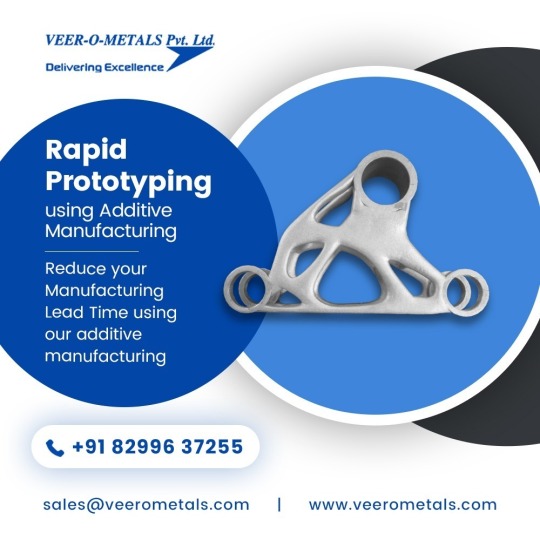
Additive Manufacturing & 3D Printing are interchangeable terms as they both describe the same process. It’s a technology where 3D parts are produced layer by layer from a material.
Additive manufacturing Process
The Additive manufacturing Process involves uploading your Computer-Aided-Design (CAD) designs directly to 3D Printer to deposit material, layer upon layer, in precise geometric shapes creating the desired Metal 3D model.
Metal Additive Manufacturing
Metal Additive Manufacturing or Metal 3D Printing is Production of 3D Parts layer by layer from a metal Material.
The print head moves horizontally and vertically and puts a new layer of build material with every pass making it possible to manufacture objects using a variety of materials.
The Metal Additive Manufacturing Technique is also involves using 3D object scanners to scan the object and direct 3D Printer to deposit material, layer upon layer creating the metal 3D Model.
This technology makes it possible for manufacturers to produce complex metal parts without any design constraints of traditional manufacturing. There are numerous benefits of 3D printing over Traditional Manufacturing namely no design constraints and complex parts can be corrected and printed quickly.
Metal Additive Manufacturing Materials
The most common Metal Additive Manufacturing Materials are namely Aluminum Alloy - AISi10Mg, Super/ Nickel Alloy - Inconel 718, PH1, GP1 and CX, Inconel 625 and HX, Stainless Steel - SS316L, Titanium - Ti6AI4V and Ti6AI4V ELI, Cobalt Chrome- MP1, Maraging Steel- MS1, Copper- CU etc.
Metal Additive Manufacturing Applications
There are numerous Metal Additive Manufacturing Applications as Additive Manufacturing is ideal for production of Low Volume and speciality Parts. We can design Functional Metal Prototypes, spare and obsolete Parts, Surgical and Dental Implants, Jewellery and decorative Arts and custom Tools quickly.
Metal Additive Manufacturing Advantages
There are numerous Metal Additive Manufacturing Advantages namely
• Design Flexibility - Use Smarter Design Geometries
• Quick Evaluation of Designs
• Create Complex Parts to deliver Maximum Performance
• Eliminate Tooling and Fixture Costs
• Rapid Product Development
• Low Raw Material Wastage
• Simplify Supply Chain using On Demand Tooling
Benefits of Metal Additive Manufacturing (Metal 3D - Printing) in Aerospace, Space, Defense, Automotive, Tooling, Oil & Gas Industry
We are outlining the benefit of Metal Additive Manufacturing across various Industries
• Create Complex Parts to deliver Maximum Performance
• Use Smarter Design Geometries
• Eliminate Tooling and Fixture Costs
• Increase Durability and Lifecycle of Parts
Benefits of Metal Additive Manufacturing in Defense Industry
• Rapid Product Development
• Reduce Part Weight by Producing optimised components
• Low Raw Material Wastage
• Produce Custom Spares and Components
Benefits of Metal Additive Manufacturing in Automotive Industry
• Design of 3D Printed Scale Models
• Prototype Validation in Pre - Manufacturing Stage
• Produce Samples and Tools at Low Cost
• Produce Custom and Lightweight Parts
Benefits of Metal Additive Manufacturing in Oil & Gas Industry
• Design Flexibility & Faster Product Development
• Economic Low Volume Production
• Faster Re-Manufacturing of High Value Components
• Simplyfy Supply Chain using On Demand Tooling
Veer-O-Metals is one of the leading Metal Additive Manufacturing company In India offering complete Metal 3D Printing Solution across Industries namely Aerospace, Space, Defense, Automotive, Heat Sink, Oil and Gas, Product Development, Conformal Cooling, Medical, Digital Inventory etc.
Veer-O-Metals (VOM) was established in 1965 and has augmented cutting edge manufacturing technology in the field of metal additive manufacturing which is an automatic process of manufacturing objects (Parts, Prototypes, tools & even assemblies) directly from their CAD models without any cutter, tools and jigs & fixtures.
As an organization VOM holds equal responsibility in meeting the industry standards, which keep us abreast of all the mandatory certifications, needed for a healthy sustenance. VOM has obtained the below certifications to meet the standards.
• AS 9100D: Certified ISO 9001
• ISO-45001:2018
• EN 15085 LL-C (Certification)
• ISO 14001: 2015
• Certified IATF 16949: 2016
• ISO 27001: 2013
You can call us at +91- 9739991967 or contact us at [email protected] or visit www.veerometals.com for all you Additive Manufacturing requirements.
#post processing of 3d printed#metal additive manufacturing service providers#metal 3d printing services in india#metal 3d printing service bangalore#metal 3d printing raw material#metal 3d printing rapid prototyping#metal 3d printing india#metal 3d printing in rapid prototyping#metal 3d printing companies in india#metal 3d printing companies in bangalore#additive metal 3d printing#additive manufacturing service in india#additive manufacturing companies in bangalore#3d priniting post processing services#3d metal printing companies
1 note
·
View note
Link
Additive Manufacturing & 3D Printing are interchangeable terms as they both describe the same process. It’s a technology where 3D parts are produced layer by layer from a material.
Additive manufacturing Process
The Additive manufacturing Process involves uploading your Computer-Aided-Design (CAD) designs directly to 3D Printer to deposit material, layer upon layer, in precise geometric shapes creating the desired Metal 3D model.
Metal Additive Manufacturing
Metal Additive Manufacturing or Metal 3D Printing is Production of 3D Parts layer by layer from a metal Material.
The print head moves horizontally and vertically and puts a new layer of build material with every pass making it possible to manufacture objects using a variety of materials.
The Metal Additive Manufacturing Technique is also involves using 3D object scanners to scan the object and direct 3D Printer to deposit material, layer upon layer creating the metal 3D Model.
This technology makes it possible for manufacturers to produce complex metal parts without any design constraints of traditional manufacturing. There are numerous benefits of 3D printing over Traditional Manufacturing namely no design constraints and complex parts can be corrected and printed quickly.
Metal Additive Manufacturing Materials
The most common Metal Additive Manufacturing Materials are namely Aluminum Alloy - AISi10Mg, Super/ Nickel Alloy - Inconel 718, PH1, GP1 and CX, Inconel 625 and HX, Stainless Steel - SS316L, Titanium - Ti6AI4V and Ti6AI4V ELI, Cobalt Chrome- MP1, Maraging Steel- MS1, Copper- CU etc.
Metal Additive Manufacturing Applications
There are numerous Metal Additive Manufacturing Applications as Additive Manufacturing is ideal for production of Low Volume and speciality Parts. We can design Functional Metal Prototypes, spare and obsolete Parts, Surgical and Dental Implants, Jewellery and decorative Arts and custom Tools quickly.
Metal Additive Manufacturing Advantages
There are numerous Metal Additive Manufacturing Advantages namely
• Design Flexibility - Use Smarter Design Geometries
• Quick Evaluation of Designs
• Create Complex Parts to deliver Maximum Performance
• Eliminate Tooling and Fixture Costs
• Rapid Product Development
• Low Raw Material Wastage
• Simplify Supply Chain using On Demand Tooling
Benefits of Metal Additive Manufacturing (Metal 3D - Printing) in Aerospace, Space, Defense, Automotive, Tooling, Oil & Gas Industry
We are outlining the benefit of Metal Additive Manufacturing across various Industries
• Create Complex Parts to deliver Maximum Performance
• Use Smarter Design Geometries
• Eliminate Tooling and Fixture Costs
• Increase Durability and Lifecycle of Parts
Benefits of Metal Additive Manufacturing in Defense Industry
• Rapid Product Development
• Reduce Part Weight by Producing optimised components
• Low Raw Material Wastage
• Produce Custom Spares and Components
Benefits of Metal Additive Manufacturing in Automotive Industry
• Design of 3D Printed Scale Models
• Prototype Validation in Pre - Manufacturing Stage
• Produce Samples and Tools at Low Cost
• Produce Custom and Lightweight Parts
Benefits of Metal Additive Manufacturing in Oil & Gas Industry
• Design Flexibility & Faster Product Development
• Economic Low Volume Production
• Faster Re-Manufacturing of High Value Components
• Simplyfy Supply Chain using On Demand Tooling
Veer-O-Metals is one of the leading Metal Additive Manufacturing company In India offering complete Metal 3D Printing Solution across Industries namely Aerospace, Space, Defense, Automotive, Heat Sink, Oil and Gas, Product Development, Conformal Cooling, Medical, Digital Inventory etc.
Veer-O-Metals (VOM) was established in 1965 and has augmented cutting edge manufacturing technology in the field of metal additive manufacturing which is an automatic process of manufacturing objects (Parts, Prototypes, tools & even assemblies) directly from their CAD models without any cutter, tools and jigs & fixtures.
As an organization VOM holds equal responsibility in meeting the industry standards, which keep us abreast of all the mandatory certifications, needed for a healthy sustenance. VOM has obtained the below certifications to meet the standards.
• AS 9100D: Certified ISO 9001
• ISO-45001:2018
• EN 15085 LL-C (Certification)
• ISO 14001: 2015
• Certified IATF 16949: 2016
• ISO 27001: 2013
You can call us at +91- 9739991967 or contact us at [email protected] or visit www.veerometals.com for all you Additive Manufacturing requirements.
#3d metal printing companies#3d priniting post processing services#additive manufacturing companies in bangalore#additive manufacturing service in india#additive metal 3d printing#metal 3d printing companies in bangalore#metal 3d printing companies in india#metal 3d printing in rapid prototyping#metal 3d printing india#metal 3d printing rapid prototyping#metal 3d printing raw material#metal 3d printing service bangalore#metal 3d printing services in india#metal additive manufacturing service providers#post processing of 3d printed
0 notes
Text
6 MOST POPULAR INDUSTRIES TO USE METAL 3D PRINTING
Will you disagree with me if I say that the long-term success of any society is highly dependent on its manufacturing? I hope you will not. Every society needs a very strong and vibrant manufacturing base. There is a well-known saying that 'If you always do what you always did, you'll always get what you have always got. This clearly states the significance of development and automation in the manufacturing industry. Additive manufacturing is fundamentally changing what we can do. There are three key elements to effectively utilize the additive manufacturing process. Additive thinking, accessible processes and cost are those elements which provide the most efficient solutions to the hindrances in the additive manufacturing sector. Metal additive manufacturing is the one that requires special mention here. Let us understand the concept, types, and major metal additive manufacturing applications.
What is Metal 3D Printing
Metal 3d printing, also known as metal additive manufacturing is one of g fastest growing technologies in the manufacturing industry. It is the most heavily invested technology in industrial and business applications. Any technology that creates metal objects layer by layer with sintering, melting and welding could be called metal 3D printing. Metal additive manufacturing stands as an umbrella term for several families of AM technologies. The application of metal 3d printing is boundless when manufacturing objects with complicated geometry. 3D printing is highly recommended for intricate parts where other types of manufacturing are inefficient or difficult to use.
Types of Metal 3D Printing
For a better understanding of the types of metal additive manufacturing, one should differentiate between powder-bed welding and deposition processes such as laser deposition welding. In powder bed welding, a slider is used to apply a thin layer of metallic material onto the building platform. Then a laser or electron beam cuts out the desired shape. Then the installation space is lowered a little and the next layer of metal powder is pushed over the object. In this way, the component is created layer by layer. The methods of metal 3d printing are categorised into four namely Selective Laser Melting (SLM), Electron Beam Melting (EBM), Laser Metal Deposition (LMD) and Metal Powder Application (MPA). SLM technology uses a bed of powder with a source of heat to create metal parts and includes Selective Laser Melting (SLS), which is also called Direct Metal Laser Sintering (DMLS) or Laser Metal Fusion (LMF). EBM is a type of additive manufacturing where the raw material is placed under a vacuum and fused from heating by an electron beam. LMD is a laser-based DED technique that selectively adds metal material onto a base workpiece in a layer-by-layer process. In powder-based LMD, a nozzle aggregates metal powder onto a workpiece, where a fibre laser melts both the powder and the workpiece into a melt pool. MPA involves blasting a fine metal powder at a target using a custom-designed nozzle.
3D Printing in Automobile Industry
3D printing has greater scope in the automobile industry. Metal additive manufacturing can be used to make moulds and thermoforming tools, and also in manufacturing grips, jigs, and fixtures. This allows automakers to produce samples and tools at low costs and to eliminate future losses in production when investing in high-cost tooling. With 3D printing, automotive designers can quickly fabricate a prototype of a physical part or assembly, from a simple interior element to a dashboard or even a scale model of an entire automobile.
3D Printing in Medical Industry
Medical 3D printing is highly in demand in both clinical and research-based healthcare activities. It involves the creation of physical replicas of anatomical structures using additive manufacturing processes. The application of 3D printing in medicine can provide many benefits like the customization and personalization of medical products, drugs, and equipment; cost-effectiveness; increased productivity; the democratization of design and manufacturing; and enhanced collaboration.
3D Printing in Aerospace Industry
In the Aerospace industry, metal additive manufacturing is used to manufacture metal brackets that perform a structural function inside aircraft. 3D printing services produce interior aircraft components such as cockpit dashboards and door handles. 3D printed prototypes enable designers to refine the form and fit of finished parts. Because component precision is a critical factor in aircraft design, 3D printers are used in the aircraft industry to provide extremely high accuracy in parts and components.
3D Printing in Architecture Industry
3D printing will simplify the process in architecture. It can render highly detailed physical models from a range of materials and colours based on a CAD model. It is an efficient process that lets architects turn out models quickly and more accurately. 3D printing allows architects to design and develop everything ranging from buildings, townships, and cities right down to terrains, landscapes and fauna with fine detail and full colour. Well-designed 3D-printed architectural models can help architects create a lasting impression on their clients.
3D Printing in Defense Industry
The additive manufacturing technique is widely used by the defence sector worldwide. Considering that speed, lighter weights, and lower costs are all paramount in this sector, additive manufacturing certainly has a role to play. 3d printing provides new ways to 3D print replacement parts on demand, whilst reducing production costs and enabling new design engineering possibilities in the defence industry.
3D Printing in Tooling Industry
Tooling is any part manufacturers use to make other parts. 3D printing provides new opportunities for different business sectors to enable easier prototyping. It could directly form the part or like a pattern for a mould that manufacturers would then use to cast a different part. It gives them the ability to create designs that are way too difficult to produce with other methods. It also allows manufacturers to build high-quality products rapidly.
Some new frontiers with 3D printing technology
A new frontier for 3D printing develops state-of-the-art soft materials able to self-heal. The scientific community is focusing its research on the multiple applications of hydrogels, polymeric materials which contain a large amount of water, that have the potential to reproduce the features of biological tissues. Direct Sound Printing is a potential game-changer in 3D Printing. Metal additive manufacturing creates physical objects from a geometrical representation by successive addition of materials. 3D printing technology is a fast-emerging technology nowadays. Apart from Metal 3D Printing, there are new frontiers like 3D Printed Lattice Structures, Bone-Like 3D Printed Structures and more efficient Engines in Drones. 3D printing can help manufacturers save time, material, and costs from traditional tooling processes. As technology in 3D printing has improved, the ability to make larger items as well as more detailed objects has become more commonplace. Ultimately, three-dimensional printing is revolutionizing the production of new devices and structures in a wide range of sectors.
Conclusion
Metal additive manufacturing has recently developed a lot to bring great benefits to different business sectors. These benefits include reduced material use, lowered costs, and production acceleration. It also enables designers and engineers to create anything from jigs and fixtures to more advanced forms like visualisation aids. The possibilities of using 3D printing for product development and manufacturing in different industries are limitless. The days are not far for you to think of outsourcing metal 3d printing for your industry. The countdown begins!
#3d metal printing companies#3d metal printing machine#3d metal printing machine manufacturers#3d metal printing near me#3d metal printing prototyping#3d priniting post processing services#3d printing in defence industry#additive laser manufacturing#additive manufactured products#additive manufacturing 3d printing#additive manufacturing advantages#additive manufacturing aerospace#additive manufacturing application#additive manufacturing companies in bangalore#additive manufacturing company#additive manufacturing company in india#additive manufacturing future#additive manufacturing material#additive manufacturing metal parts#additive manufacturing near me#additive manufacturing process#additive manufacturing service in india#additive manufacturing technique#additive manufacturing types#additive metal 3d printing#advantages of 3d printers#automotive industry 3d printing#benefit of metal 3d printing#best 3d printing companies in bangalore#dmls 3d printer
0 notes
Link
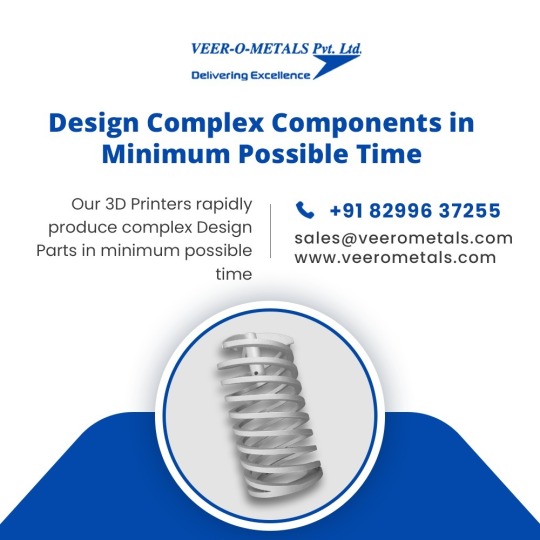
Will you disagree with me if I say that the long-term success of any society is highly dependent on its manufacturing? I hope you will not. Every society needs a very strong and vibrant manufacturing base. There is a well-known saying that 'If you always do what you always did, you'll always get what you have always got. This clearly states the significance of development and automation in the manufacturing industry. Additive manufacturing is fundamentally changing what we can do. There are three key elements to effectively utilize the additive manufacturing process. Additive thinking, accessible processes and cost are those elements which provide the most efficient solutions to the hindrances in the additive manufacturing sector. Metal additive manufacturing is the one that requires special mention here. Let us understand the concept, types, and major metal additive manufacturing applications.
What is Metal 3D Printing
Metal 3d printing, also known as metal additive manufacturing is one of g fastest growing technologies in the manufacturing industry. It is the most heavily invested technology in industrial and business applications. Any technology that creates metal objects layer by layer with sintering, melting and welding could be called metal 3D printing. Metal additive manufacturing stands as an umbrella term for several families of AM technologies. The application of metal 3d printing is boundless when manufacturing objects with complicated geometry. 3D printing is highly recommended for intricate parts where other types of manufacturing are inefficient or difficult to use.
Types of Metal 3D Printing
For a better understanding of the types of metal additive manufacturing, one should differentiate between powder-bed welding and deposition processes such as laser deposition welding. In powder bed welding, a slider is used to apply a thin layer of metallic material onto the building platform. Then a laser or electron beam cuts out the desired shape. Then the installation space is lowered a little and the next layer of metal powder is pushed over the object. In this way, the component is created layer by layer. The methods of metal 3d printing are categorised into four namely Selective Laser Melting (SLM), Electron Beam Melting (EBM), Laser Metal Deposition (LMD) and Metal Powder Application (MPA). SLM technology uses a bed of powder with a source of heat to create metal parts and includes Selective Laser Melting (SLS), which is also called Direct Metal Laser Sintering (DMLS) or Laser Metal Fusion (LMF). EBM is a type of additive manufacturing where the raw material is placed under a vacuum and fused from heating by an electron beam. LMD is a laser-based DED technique that selectively adds metal material onto a base workpiece in a layer-by-layer process. In powder-based LMD, a nozzle aggregates metal powder onto a workpiece, where a fibre laser melts both the powder and the workpiece into a melt pool. MPA involves blasting a fine metal powder at a target using a custom-designed nozzle.
3D Printing in Automobile Industry
3D printing has greater scope in the automobile industry. Metal additive manufacturing can be used to make moulds and thermoforming tools, and also in manufacturing grips, jigs, and fixtures. This allows automakers to produce samples and tools at low costs and to eliminate future losses in production when investing in high-cost tooling. With 3D printing, automotive designers can quickly fabricate a prototype of a physical part or assembly, from a simple interior element to a dashboard or even a scale model of an entire automobile.
3D Printing in Medical Industry
Medical 3D printing is highly in demand in both clinical and research-based healthcare activities. It involves the creation of physical replicas of anatomical structures using additive manufacturing processes. The application of 3D printing in medicine can provide many benefits like the customization and personalization of medical products, drugs, and equipment; cost-effectiveness; increased productivity; the democratization of design and manufacturing; and enhanced collaboration.
3D Printing in Aerospace Industry
In the Aerospace industry, metal additive manufacturing is used to manufacture metal brackets that perform a structural function inside aircraft. 3D printing services produce interior aircraft components such as cockpit dashboards and door handles. 3D printed prototypes enable designers to refine the form and fit of finished parts. Because component precision is a critical factor in aircraft design, 3D printers are used in the aircraft industry to provide extremely high accuracy in parts and components.
3D Printing in Architecture Industry
3D printing will simplify the process in architecture. It can render highly detailed physical models from a range of materials and colours based on a CAD model. It is an efficient process that lets architects turn out models quickly and more accurately. 3D printing allows architects to design and develop everything ranging from buildings, townships, and cities right down to terrains, landscapes and fauna with fine detail and full colour. Well-designed 3D-printed architectural models can help architects create a lasting impression on their clients.
3D Printing in Defense Industry
The additive manufacturing technique is widely used by the defence sector worldwide. Considering that speed, lighter weights, and lower costs are all paramount in this sector, additive manufacturing certainly has a role to play. 3d printing provides new ways to 3D print replacement parts on demand, whilst reducing production costs and enabling new design engineering possibilities in the defence industry.
3D Printing in Tooling Industry
Tooling is any part manufacturers use to make other parts. 3D printing provides new opportunities for different business sectors to enable easier prototyping. It could directly form the part or like a pattern for a mould that manufacturers would then use to cast a different part. It gives them the ability to create designs that are way too difficult to produce with other methods. It also allows manufacturers to build high-quality products rapidly.
Some new frontiers with 3D printing technology
A new frontier for 3D printing develops state-of-the-art soft materials able to self-heal. The scientific community is focusing its research on the multiple applications of hydrogels, polymeric materials which contain a large amount of water, that have the potential to reproduce the features of biological tissues. Direct Sound Printing is a potential game-changer in 3D Printing. Metal additive manufacturing creates physical objects from a geometrical representation by successive addition of materials. 3D printing technology is a fast-emerging technology nowadays. Apart from Metal 3D Printing, there are new frontiers like 3D Printed Lattice Structures, Bone-Like 3D Printed Structures and more efficient Engines in Drones. 3D printing can help manufacturers save time, material, and costs from traditional tooling processes. As technology in 3D printing has improved, the ability to make larger items as well as more detailed objects has become more commonplace. Ultimately, three-dimensional printing is revolutionizing the production of new devices and structures in a wide range of sectors.
Conclusion
Metal additive manufacturing has recently developed a lot to bring great benefits to different business sectors. These benefits include reduced material use, lowered costs, and production acceleration. It also enables designers and engineers to create anything from jigs and fixtures to more advanced forms like visualisation aids. The possibilities of using 3D printing for product development and manufacturing in different industries are limitless. The days are not far for you to think of outsourcing metal 3d printing for your industry. The countdown begins!
#metal 3d printing in mumbai#metal 3d printing companies in india#metal 3d printing companies in bangalore#metal 3d printing bangalore#materials for additive manufacturing#dmls printer manufacturers#additive metal 3d printing#additive manufacturing service in india#additive manufacturing metal parts#additive manufacturing material#additive manufacturing company in india#additive manufacturing companies in bangalore#additive manufactured products#3d printing in defence industry#3d priniting post processing services#3d metal printing companies
0 notes
Photo
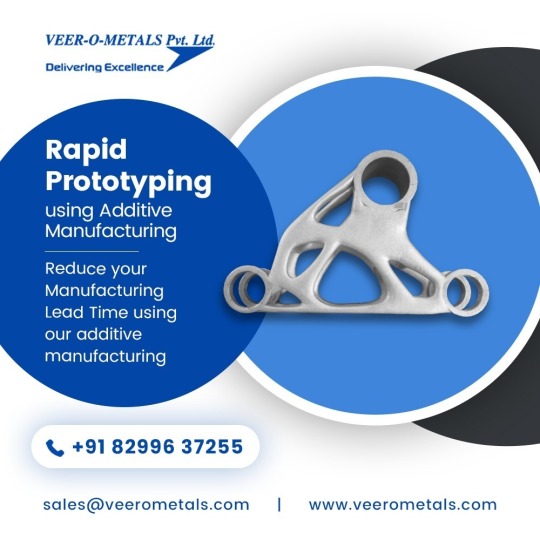
metal parts manufacturing companies
#what is metal additive manufacturing#metal parts#post processing of 3d printed#metals manufacturing company#metal products manufacturers#metal parts manufacturing companies#metal manufacturers in india#metal companies in india#metal additive manufacturing systems#metal additive manufacturing services#metal additive manufacturing service providers#metal additive manufacturing post processing#metal additive manufacturing materials#metal additive manufacturing machine#metal additive manufacturing in india#metal additive manufacturing companies#metal additive manufacturing applications#metal additive manufacturing#metal 3d printing services in india#metal 3d printing service bangalore#metal 3d printing raw material#metal 3d printing rapid prototyping#metal 3d printing process#metal 3d printing post processing#metal 3d printing manufacturing#metal 3d printing india#metal 3d printing in rapid prototyping#metal 3d printing in mumbai
0 notes
Text
6 MOST POPULAR INDUSTRIES TO USE METAL 3D PRINTING
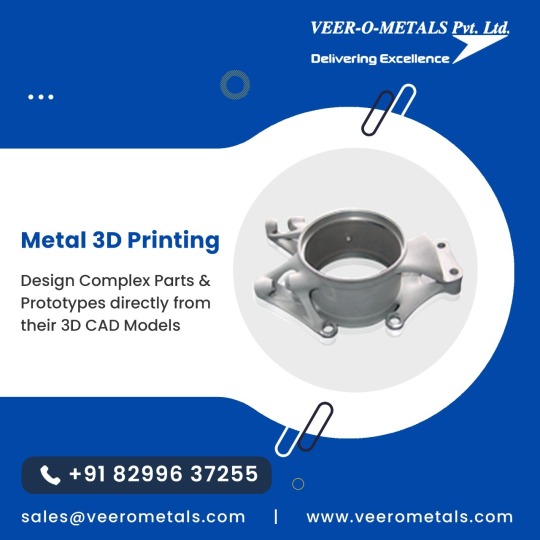
Will you disagree with me if I say that the long-term success of any society is highly dependent on its manufacturing? I hope you will not. Every society needs a very strong and vibrant manufacturing base. There is a well-known saying that 'If you always do what you always did, you'll always get what you have always got. This clearly states the significance of development and automation in the manufacturing industry. Additive manufacturing is fundamentally changing what we can do. There are three key elements to effectively utilize the additive manufacturing process. Additive thinking, accessible processes and cost are those elements which provide the most efficient solutions to the hindrances in the additive manufacturing sector. Metal additive manufacturing is the one that requires special mention here. Let us understand the concept, types, and major metal additive manufacturing applications.
What is Metal 3D Printing
Metal 3d printing, also known as metal additive manufacturing is one of g fastest growing technologies in the manufacturing industry. It is the most heavily invested technology in industrial and business applications. Any technology that creates metal objects layer by layer with sintering, melting and welding could be called metal 3D printing. Metal additive manufacturing stands as an umbrella term for several families of AM technologies. The application of metal 3d printing is boundless when manufacturing objects with complicated geometry. 3D printing is highly recommended for intricate parts where other types of manufacturing are inefficient or difficult to use.
Types of Metal 3D Printing
For a better understanding of the types of metal additive manufacturing, one should differentiate between powder-bed welding and deposition processes such as laser deposition welding. In powder bed welding, a slider is used to apply a thin layer of metallic material onto the building platform. Then a laser or electron beam cuts out the desired shape. Then the installation space is lowered a little and the next layer of metal powder is pushed over the object. In this way, the component is created layer by layer. The methods of metal 3d printing are categorised into four namely Selective Laser Melting (SLM), Electron Beam Melting (EBM), Laser Metal Deposition (LMD) and Metal Powder Application (MPA). SLM technology uses a bed of powder with a source of heat to create metal parts and includes Selective Laser Melting (SLS), which is also called Direct Metal Laser Sintering (DMLS) or Laser Metal Fusion (LMF). EBM is a type of additive manufacturing where the raw material is placed under a vacuum and fused from heating by an electron beam. LMD is a laser-based DED technique that selectively adds metal material onto a base workpiece in a layer-by-layer process. In powder-based LMD, a nozzle aggregates metal powder onto a workpiece, where a fibre laser melts both the powder and the workpiece into a melt pool. MPA involves blasting a fine metal powder at a target using a custom-designed nozzle.
3D Printing in Automobile Industry
3D printing has greater scope in the automobile industry. Metal additive manufacturing can be used to make moulds and thermoforming tools, and also in manufacturing grips, jigs, and fixtures. This allows automakers to produce samples and tools at low costs and to eliminate future losses in production when investing in high-cost tooling. With 3D printing, automotive designers can quickly fabricate a prototype of a physical part or assembly, from a simple interior element to a dashboard or even a scale model of an entire automobile.
3D Printing in Medical Industry
Medical 3D printing is highly in demand in both clinical and research-based healthcare activities. It involves the creation of physical replicas of anatomical structures using additive manufacturing processes. The application of 3D printing in medicine can provide many benefits like the customization and personalization of medical products, drugs, and equipment; cost-effectiveness; increased productivity; the democratization of design and manufacturing; and enhanced collaboration.
3D Printing in Aerospace Industry
In the Aerospace industry, metal additive manufacturing is used to manufacture metal brackets that perform a structural function inside aircraft. 3D printing services produce interior aircraft components such as cockpit dashboards and door handles. 3D printed prototypes enable designers to refine the form and fit of finished parts. Because component precision is a critical factor in aircraft design, 3D printers are used in the aircraft industry to provide extremely high accuracy in parts and components.
3D Printing in Architecture Industry
3D printing will simplify the process in architecture. It can render highly detailed physical models from a range of materials and colours based on a CAD model. It is an efficient process that lets architects turn out models quickly and more accurately. 3D printing allows architects to design and develop everything ranging from buildings, townships, and cities right down to terrains, landscapes and fauna with fine detail and full colour. Well-designed 3D-printed architectural models can help architects create a lasting impression on their clients.
3D Printing in Defense Industry
The additive manufacturing technique is widely used by the defence sector worldwide. Considering that speed, lighter weights, and lower costs are all paramount in this sector, additive manufacturing certainly has a role to play. 3d printing provides new ways to 3D print replacement parts on demand, whilst reducing production costs and enabling new design engineering possibilities in the defence industry.
3D Printing in Tooling Industry
Tooling is any part manufacturers use to make other parts. 3D printing provides new opportunities for different business sectors to enable easier prototyping. It could directly form the part or like a pattern for a mould that manufacturers would then use to cast a different part. It gives them the ability to create designs that are way too difficult to produce with other methods. It also allows manufacturers to build high-quality products rapidly.
Some new frontiers with 3D printing technology
A new frontier for 3D printing develops state-of-the-art soft materials able to self-heal. The scientific community is focusing its research on the multiple applications of hydrogels, polymeric materials which contain a large amount of water, that have the potential to reproduce the features of biological tissues. Direct Sound Printing is a potential game-changer in 3D Printing. Metal additive manufacturing creates physical objects from a geometrical representation by successive addition of materials. 3D printing technology is a fast-emerging technology nowadays. Apart from Metal 3D Printing, there are new frontiers like 3D Printed Lattice Structures, Bone-Like 3D Printed Structures and more efficient Engines in Drones. 3D printing can help manufacturers save time, material, and costs from traditional tooling processes. As technology in 3D printing has improved, the ability to make larger items as well as more detailed objects has become more commonplace. Ultimately, three-dimensional printing is revolutionizing the production of new devices and structures in a wide range of sectors.
Conclusion
Metal additive manufacturing has recently developed a lot to bring great benefits to different business sectors. These benefits include reduced material use, lowered costs, and production acceleration. It also enables designers and engineers to create anything from jigs and fixtures to more advanced forms like visualisation aids. The possibilities of using 3D printing for product development and manufacturing in different industries are limitless. The days are not far for you to think of outsourcing metal 3d printing for your industry. The countdown begins!
#3d metal printing companies#3d priniting post processing services#3d printing in defence industry#additive manufactured products#additive manufacturing companies in bangalore#additive manufacturing company in india#additive manufacturing material#additive manufacturing metal parts#additive manufacturing service in india#additive metal 3d printing#dmls printer manufacturers#materials for additive manufacturing#metal 3d printing bangalore#metal 3d printing companies in bangalore#metal 3d printing companies in india#metal 3d printing in mumbai#metal 3d printing in rapid prototyping#metal 3d printing india#metal 3d printing manufacturing#metal 3d printing post processing#metal 3d printing process#metal 3d printing rapid prototyping#metal 3d printing raw material#metal 3d printing service bangalore#metal 3d printing services in india#metal additive manufacturing#metal additive manufacturing applications#metal additive manufacturing companies#metal additive manufacturing in india#metal additive manufacturing machine
0 notes
Text
6 MOST POPULAR INDUSTRIES TO USE METAL 3D PRINTING
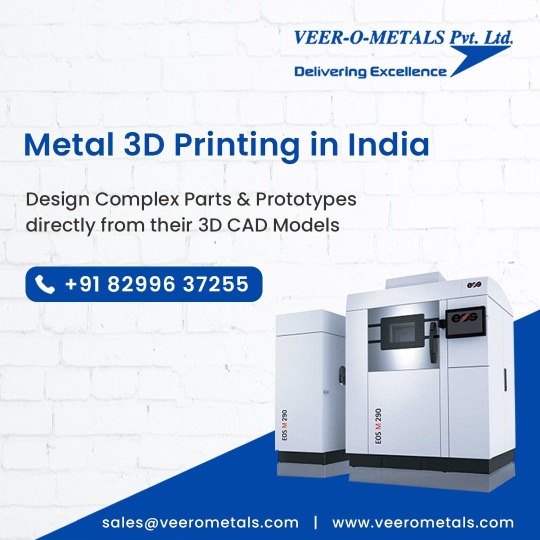
Will you disagree with me if I say that the long-term success of any society is highly dependent on its manufacturing? I hope you will not. Every society needs a very strong and vibrant manufacturing base. There is a well-known saying that 'If you always do what you always did, you'll always get what you have always got. This clearly states the significance of development and automation in the manufacturing industry. Additive manufacturing is fundamentally changing what we can do. There are three key elements to effectively utilize the additive manufacturing process. Additive thinking, accessible processes and cost are those elements which provide the most efficient solutions to the hindrances in the additive manufacturing sector. Metal additive manufacturing is the one that requires special mention here. Let us understand the concept, types, and major metal additive manufacturing applications.
What is Metal 3D Printing
Metal 3d printing, also known as metal additive manufacturing is one of g fastest growing technologies in the manufacturing industry. It is the most heavily invested technology in industrial and business applications. Any technology that creates metal objects layer by layer with sintering, melting and welding could be called metal 3D printing. Metal additive manufacturing stands as an umbrella term for several families of AM technologies. The application of metal 3d printing is boundless when manufacturing objects with complicated geometry. 3D printing is highly recommended for intricate parts where other types of manufacturing are inefficient or difficult to use.
Types of Metal 3D Printing
For a better understanding of the types of metal additive manufacturing, one should differentiate between powder-bed welding and deposition processes such as laser deposition welding. In powder bed welding, a slider is used to apply a thin layer of metallic material onto the building platform. Then a laser or electron beam cuts out the desired shape. Then the installation space is lowered a little and the next layer of metal powder is pushed over the object. In this way, the component is created layer by layer. The methods of metal 3d printing are categorised into four namely Selective Laser Melting (SLM), Electron Beam Melting (EBM), Laser Metal Deposition (LMD) and Metal Powder Application (MPA). SLM technology uses a bed of powder with a source of heat to create metal parts and includes Selective Laser Melting (SLS), which is also called Direct Metal Laser Sintering (DMLS) or Laser Metal Fusion (LMF). EBM is a type of additive manufacturing where the raw material is placed under a vacuum and fused from heating by an electron beam. LMD is a laser-based DED technique that selectively adds metal material onto a base workpiece in a layer-by-layer process. In powder-based LMD, a nozzle aggregates metal powder onto a workpiece, where a fibre laser melts both the powder and the workpiece into a melt pool. MPA involves blasting a fine metal powder at a target using a custom-designed nozzle.
3D Printing in Automobile Industry
3D printing has greater scope in the automobile industry. Metal additive manufacturing can be used to make moulds and thermoforming tools, and also in manufacturing grips, jigs, and fixtures. This allows automakers to produce samples and tools at low costs and to eliminate future losses in production when investing in high-cost tooling. With 3D printing, automotive designers can quickly fabricate a prototype of a physical part or assembly, from a simple interior element to a dashboard or even a scale model of an entire automobile.
3D Printing in Medical Industry
Medical 3D printing is highly in demand in both clinical and research-based healthcare activities. It involves the creation of physical replicas of anatomical structures using additive manufacturing processes. The application of 3D printing in medicine can provide many benefits like the customization and personalization of medical products, drugs, and equipment; cost-effectiveness; increased productivity; the democratization of design and manufacturing; and enhanced collaboration.
3D Printing in Aerospace Industry
In the Aerospace industry, metal additive manufacturing is used to manufacture metal brackets that perform a structural function inside aircraft. 3D printing services produce interior aircraft components such as cockpit dashboards and door handles. 3D printed prototypes enable designers to refine the form and fit of finished parts. Because component precision is a critical factor in aircraft design, 3D printers are used in the aircraft industry to provide extremely high accuracy in parts and components.
3D Printing in Architecture Industry
3D printing will simplify the process in architecture. It can render highly detailed physical models from a range of materials and colours based on a CAD model. It is an efficient process that lets architects turn out models quickly and more accurately. 3D printing allows architects to design and develop everything ranging from buildings, townships, and cities right down to terrains, landscapes and fauna with fine detail and full colour. Well-designed 3D-printed architectural models can help architects create a lasting impression on their clients.
3D Printing in Defense Industry
The additive manufacturing technique is widely used by the defence sector worldwide. Considering that speed, lighter weights, and lower costs are all paramount in this sector, additive manufacturing certainly has a role to play. 3d printing provides new ways to 3D print replacement parts on demand, whilst reducing production costs and enabling new design engineering possibilities in the defence industry.
3D Printing in Tooling Industry
Tooling is any part manufacturers use to make other parts. 3D printing provides new opportunities for different business sectors to enable easier prototyping. It could directly form the part or like a pattern for a mould that manufacturers would then use to cast a different part. It gives them the ability to create designs that are way too difficult to produce with other methods. It also allows manufacturers to build high-quality products rapidly.
Some new frontiers with 3D printing technology
A new frontier for 3D printing develops state-of-the-art soft materials able to self-heal. The scientific community is focusing its research on the multiple applications of hydrogels, polymeric materials which contain a large amount of water, that have the potential to reproduce the features of biological tissues. Direct Sound Printing is a potential game-changer in 3D Printing. Metal additive manufacturing creates physical objects from a geometrical representation by successive addition of materials. 3D printing technology is a fast-emerging technology nowadays. Apart from Metal 3D Printing, there are new frontiers like 3D Printed Lattice Structures, Bone-Like 3D Printed Structures and more efficient Engines in Drones. 3D printing can help manufacturers save time, material, and costs from traditional tooling processes. As technology in 3D printing has improved, the ability to make larger items as well as more detailed objects has become more commonplace. Ultimately, three-dimensional printing is revolutionizing the production of new devices and structures in a wide range of sectors.
Conclusion
Metal additive manufacturing has recently developed a lot to bring great benefits to different business sectors. These benefits include reduced material use, lowered costs, and production acceleration. It also enables designers and engineers to create anything from jigs and fixtures to more advanced forms like visualisation aids. The possibilities of using 3D printing for product development and manufacturing in different industries are limitless. The days are not far for you to think of outsourcing metal 3d printing for your industry. The countdown begins!
0 notes
Photo
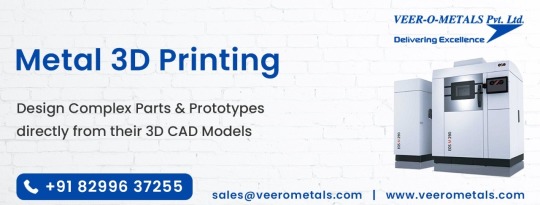
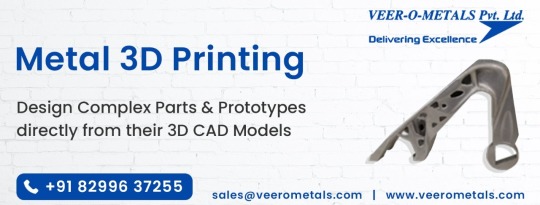
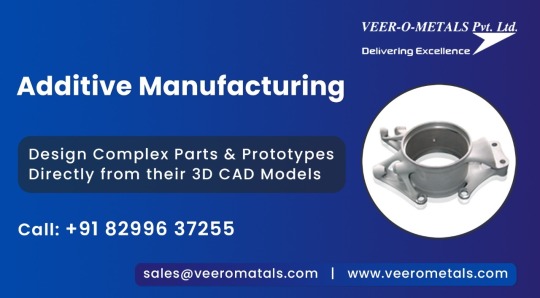

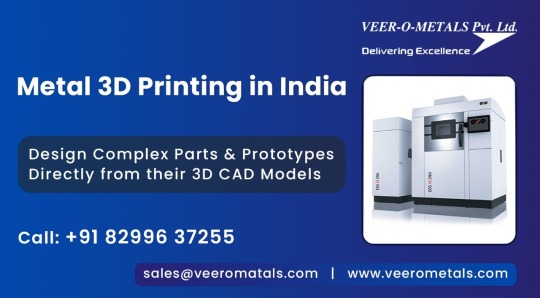
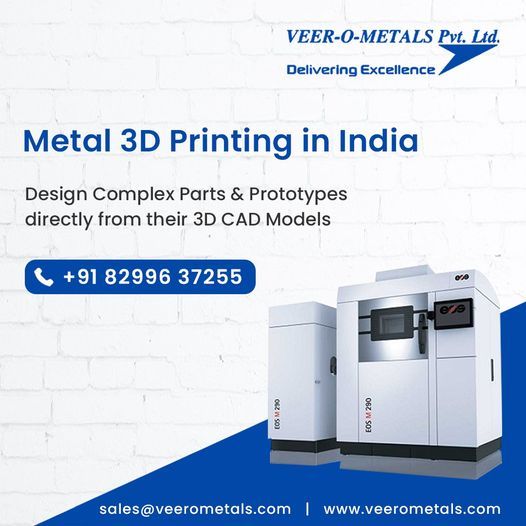

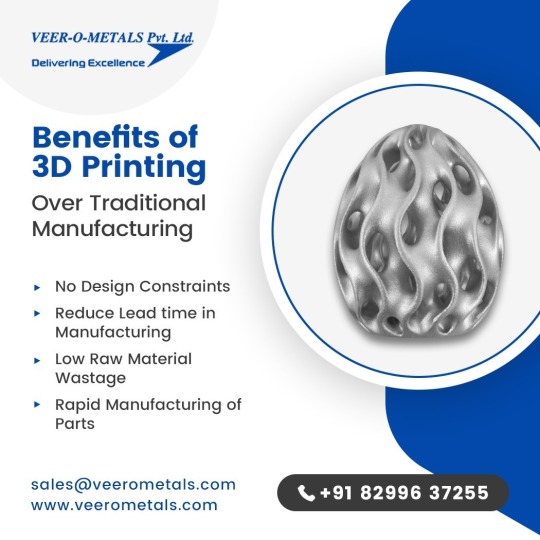
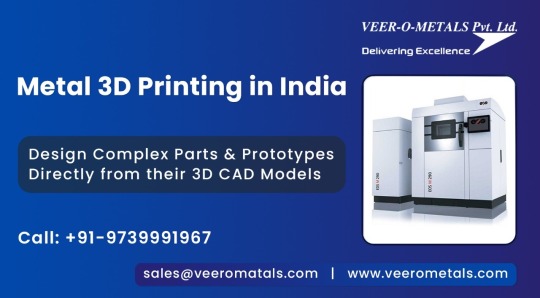
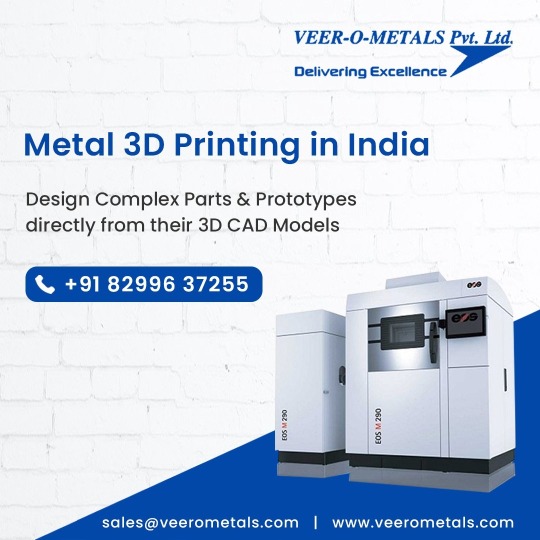
metal additive manufacturing - metal 3d printing services in india
#metal additive manufacturing additive manufacturing process additive printing additive manufacturing design additive metal 3d printing addit#metal additive manufacturing applications#metal additive manufacturing companies#metal additive manufacturing in india#metal additive manufacturing machine#metal additive manufacturing materials#metal additive manufacturing post processing#metal additive manufacturing service providers#3d metal printing companies 3d metal printing machine 3d metal printing machine manufacturers 3d metal printing near me 3d metal printin#3d metal printing companies#3d priniting post processing services#3d printing in defence industry#additive manufactured products#additive manufacturing companies in bangalore#additive manufacturing company in india#additive manufacturing material#additive manufacturing metal parts#additive manufacturing service in india#additive metal 3d printing#dmls printer manufacturers#materials for additive manufacturing#metal 3d printing bangalore#metal 3d printing companies in bangalore#metal 3d printing companies in india#metal 3d printing in mumbai#metal 3d printing in rapid prototyping#metal 3d printing india#metal 3d printing manufacturing#metal 3d printing post processing#metal 3d printing process
1 note
·
View note